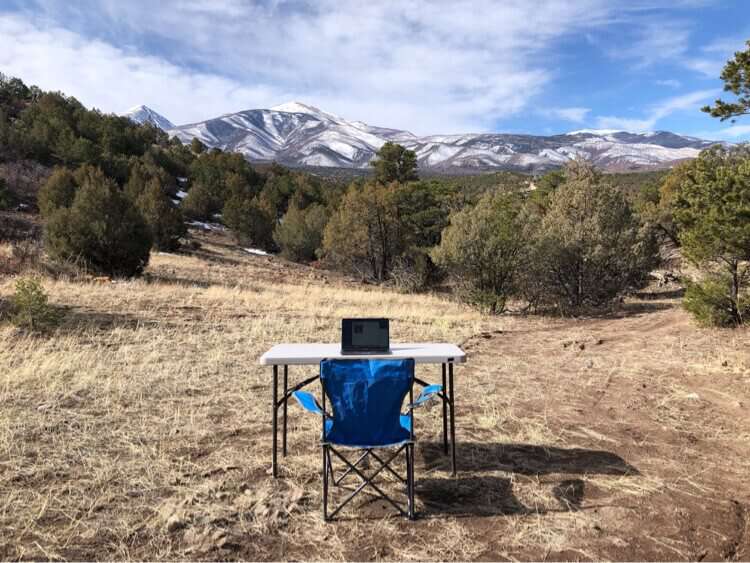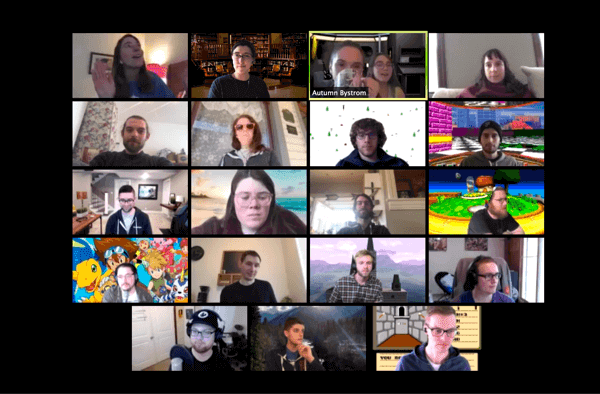Formidable, by design, is a distributed global company uniquely suited for remote work. Most of us choose to work remotely part of the time, and more than a dozen of us are what we consider "permanently remote". With the type of work we do it's fairly easy to work from a coffee shop, a park, a balcony, or one of our four physical offices.

Matt Keith's remote office in glorious Colorado
Our success with working remotely is due, in part, to one of our core values: Autonomy. We treat our employees like the honest, responsible adults they are. That means we trust them to make good decisions and get their work done—however they need to get it done. When people have the time, space, and flexibility to work how they like, it’s easier for them to tap into their creativity and produce a better work product.
So when current conditions necessitated that we all shift to remote work, we decided to share some of our best practices back with the community. Sam Morrison detailed several tips on how to manage remote teams last week. In this post, we highlight what works for our staff, what doesn't, and allow you to choose what you can adapt to your own WFH situations.
Time and Space Management
First things first: Always get dressed. This act helps your brain transition from a "lazy morning" to a more alert state. If you treat your remote day the same as one in an office, you'll put yourself into the headspace to do work. With the sheer abundance of video calls we now take, you'll also be prepared to present well on screen.
Timeboxing your day can be helpful. If you have a dog, walk your dog every few hours so that you will take breaks and get some exercise to boot.
We recommend you have a dedicated workspace and a set schedule to work and take calls. This will keep you focused and on task, and when the day ends, you can leave that space as if you've left the office, allowing yourself to separate work from your personal life. Without that separation, you run the risk of never turning off or overworking.

Dillon Mulroy and his dog Winnie, taking a break
Communication and Technology
Turning on your video for video calls is important: so much is presented in non-verbal communication that having those visual clues available will smooth out the choppiness of a conference call and allow you to feel more connected while being efficient.
With our clients, we make a point to over-communicate when we can't be co-located in an office with them. In doing so, we can anticipate their needs and be both responsive and helpful partners.
Working remotely frees you from having a regimented work day. Adopting distributed work best practices and embracing tools that let you work truly asynchronously (like pull request code review flows; written proposals with review periods) let's you take back control of your day and schedule, while staying available for your team.
We rely on Slack for continual communication—both with our colleagues and our clients. To this point, good written communications become imperative when working in a distributed way, and empowering your employees to hone their writing skills can only pay dividends in the long run. Setting your Slack status accordingly, and abiding by others' statuses, is extremely helpful. Double-check that you're not sending a Slack to someone who's on a call. If you need to focus, it's perfectly acceptable to log out of Slack for a while, but don't go AWOL. Let your team know that you need an hour or two or pure concentration before you log back in.
And while several of us rely on extra monitors, and ergonomic chairs and desks, the one thing that is a must-have across the board is stable, fast bandwidth. If you're setting up a home office, don't skimp on your broadband plan. You'll pay for it in lagging builds and nearly useless video conferences.

Remote Formidable coffee break, or Fika, via Zoom
Pitfalls and Gotchas
As we are all learning the hard way, there are some drawbacks to working remotely. Depending on your personality, you might have the tendency to work more than you should, in an attempt to "prove" that you are valuable as an employee. With the right level of communication, this isn't necessary and shouldn't be celebrated.
Being remote can cause feelings of isolation, especially to people who thrive on an in-person collaborative environment. To combat that, we've been hosting daily coffee meetups called Fikas, where all can join a group Zoom meeting and be social. Our London office often leaves Talky.io up and open so that colleagues can pop in, chat, or work in the virtual presence of one another. We also maintain casual Slack channels where we share photos of our pets and families so as to feel part of something larger.
Is This the New Normal?
The answer is yes, no, and maybe. 🤔
The COVID-19 pandemic has mandated that a quarter of the Earth's population now isolate in their homes, working from those locations where possible. For companies that were hesitant to permit workplace flexibility before, this forced experiment can show the real benefits of WFH: reduced carbon emissions due to less commuting, more time to work, the ability to control your own space, and more flexibility in your schedule.
However, for many, nothing can replace the camaraderie of working with and near your co-workers. Spontaneous moments and meetings often bear surprising fruit and for those who crave that interaction, no amount of distance-enabling technology will replace it. While you may find more time to focus, you do have to be more mindful to actively reach out to colleagues so as not to lose touch.
Yet, in today's situation, we do not know how long this experiment will last, and it will likely be a long time before work returns to the "old normal." By then we may have fully adapted to this new paradigm.
This article features contributions from the following Formidable staff: Brittany Feenstra, Per Nilsson, Steven Musumeche, Emma Broback, Danielle Ahmed, Emma Brillhart, Lorenzo Sciandra, and Dillon Mulroy.


